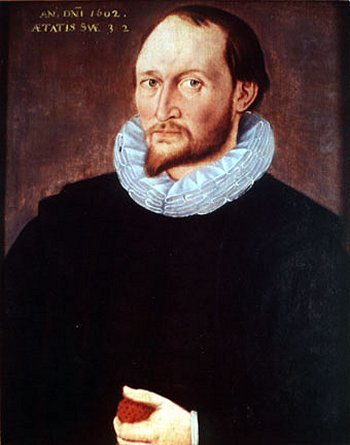Thomas Harriot
Today, England's Galileo. The University of Houston's College of Engineering presents this series about the machines that make our civilization run, and the people whose ingenuity created them.
We get so focused on Galileo that we forget he was not working in a vacuum. For example, let's meet Thomas Harriot, born in 1560 in Oxford, England, four years before Galileo. Harriot would travel far before his and Galileo's paths touched.
First, after he graduated from Oxford, Walter Ralegh hired him for his knowledge of maps and navigation. Ralegh took him off to Virginia and the Roanoke Colony. Harriot spent two years in the New World, where he became addicted to tobacco. His report, written after his re-turn, praised tobacco's healing powers. Naturally, he died at the early age of 61 from cancer of the nose.
After his America adventure, up until the Gunpowder Plot, Harriot worked on problems of geometry, algebra, and optics. His patron was an amateur scientist, the Earl of Northumberland. When the Plot failed, he and the Earl were marched off to the Tower of London as suspects. Harriot was soon released for lack of evidence. The Earl languished there for seventeen years.
But the Earl had settled a house and pension on Harriot. So he continued his studies, now veering ever more strongly toward optics. Practical telescopes had appeared in the Netherlands in 1608 and the next year Harriot had one. Whether he'd bought it or built his own, we don't know; but he turned it upon the night skies.
Aristotle's science, now woven into Church doctrine, held that the Moon was a perfect crystalline substance. Harriot saw, and sketched, a jagged dividing line between lit and unlit portions of the moon. Just a few months later, Galileo built his own telescope and saw the same thing. It was a severe challenge to Aristotle.
At first, Galileo made better sketches. And, surprisingly, he got away with claiming the supposedly perfect Moon to be, in fact, rough. Galileo's troubles with the Church began later, when he agreed with Copernicus that the solar system is centered, not on the Earth, but on the Sun.
Harriot had to be, and was, more cautious. Already under suspicion of being an unbeliever, he just recorded what he saw, without making any claims about the nature of the Moon. However, by 1611, he'd drawn the first detailed map of the Moon's surface.
Both Galileo and Harriot then called another heavenly object's perfection into question -- the Sun. Others had reported naked-eye observations of spots on the Sun. Then, late in the year 1610, both Harriot and Galileo used their telescopes to remove all doubt that the Sun was spotted.
There's so much more. Harriot identified Snell's law of optics twenty years before Snell did. He'd learned to speak Algonquin in America. It was he who showed that algebra could be done, not in clumsy words, but by manipulating symbols -- as we do today.
Why then should this brilliant polymath be so invisible? Perhaps it's because history itself is too large to hold. Maybe one Galileo is all we can tolerate in each era.
I'm John Lienhard, at the University of Houston, where we're interested in the way inventive minds work.
J. W. Shirley, Thomas Harriot: A Biography. (Oxford: Clarendon Press, 1983)
J. A. Lohne, Harriot (or Hariot), Thomas. C. C. Gillispie, ed., Dictionary of Scientific Biography, Vol. VI (New York: Charles Scribner's Sons, 1972).
J. J. Roche, Harriot, Thomas, Oxford Dictionary of National Biography, Vol. 25, (Oxford: Oxford University Press, 2004): pp. 364-397.
I am grateful to UH colleagues Vern Paulsen (mathematics) and Cathy Patterson (History) for their very helpful counsel) Also, I've used Sir Walter Ralegh's own spelling of his name, here, in place of the more familiar spelling, Raleigh.

Portrait of Thomas Harriot which hangs in Trinity College, Oxford.

Harriot's final (1610) Moon map from his archive at Petworth House, in Sussex